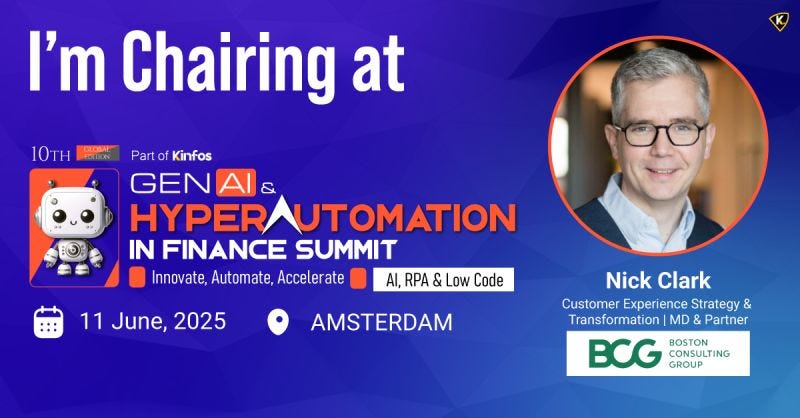The year is 2030. Avery is Head of Customer Service at a large telecoms company. Here’s what a typical working day looks like…
8:30am - 9:30am: Arrival
Avery arrives fresh at the office after an early-morning run and a trip on an electric rideshare vehicle. She logs into her tablet and gets a message from her AI Personal Work Assistant (PWA).
Good morning Avery! I noticed you have too many meetings today, so I have shifted your catch-up with the Head of Digital to Friday. Let me know if you need any more help with your schedule.
Next she checks the contact centre performance dashboard, where she can see the performance of customer service across all channels (human and AI) on a single screen. An executive summary has already been written for her
Calls spiked at 11:30am yesterday, 55% above forecast. Overall, calls were 15% above forecast (~6500 excess calls).
95% of the excess calls were in response to a marketing campaign about the new Megabundle tariff. 70% of these calls were from customers who have recently signed a contract on the old tariff, asking for a discount
Of the 6500 excess calls:
25% (1600) were received from customer AI agents and handled fully through machine-to-machine interactions
30% (2000) were from customers, but handled fully by our own AI agents. Customer Effort Score was 75%
45% (2900) were handled by our customer service reps. Customer Effort Score was 65%, and average handling time was 450 seconds. 40% of CSRs struggled to explain the new tariff.
Total cost to handle these excess calls was $3k in AI consumption and $12k in human resource, total $15k
Revenue risk from additional customer effort estimated at $100k in lost customer lifetime value
Recommendation: in future, marketing communications about new tariffs should be personalised to customers who have recently signed new contracts
Recommendation: additional virtual training needed for the 40% of CSRs who struggled to explain the new tariffs. Training modules can be built into schedules over the next 7 days without threatening service levels.
Avery’s PWA has been monitoring this message too, and suggests:
You have your regular catch up with the Customer Marketing team this afternoon. I will make sure this is on the agenda and send them this data now.
Avery looks out of the window and marvels at how, just 5 years ago, when she was Head of Workforce Management, she would have spent all day trying to get answers like this, and even then would not have felt confident of the answer.
9:30am - 10:00am: On the floor
Avery leaves her office and walks onto the contact centre floor. It’s a hive of activity, but not as noisy as it used to be as less people are talking on the phone than in the old days. Over half of the desks are are filled with Experience Engineers - experts who continuously tune and improve AI agents and knowledge content. The remainder of the team are still frontline Customer Service Representatives, but of these, over 70% are serving customers with chat messaging, not phone calls.
She introduces herself to a group of new employees, telling them that she started out her career on the phones and asking them of their experiences of the company’s customers so far. She suggests that they all sign up for one of the regular customer experience ride-alongs, in which employees get to visit customers in their own home and spend time understanding their needs.
Before going back to her office, she stops by at the desk of one of the supervisors, Kai. Kai mentions that call volumes are still 40% above forecast this morning, but his team have tweaked the chatbot responses so that now over 80% are handled by the bot. It’s only a temporary measure, as Customer Effort Score has also gone down as a result, but Kai is confident that it will help them maintain service levels for today.
10:00am - 10:30am: Outsourcer call
Avery has a virtual meeting with the operational heads at all three outsourced service partners that she works with. One of the partners has identified an opportunity to cross-sell a TV package to customers who call in overnight. Avery knows that this will need compliance sign off, but is able to get a preliminary agreement immediately from the AI agent provided by the compliance team. They agree to set up a pilot starting this evening.
In the Augmented Reality meeting, she can tell from the body language that all three partners are worried about something. When pressed, they are concerned that they will be penalised for the additional calls that came in yesterday. Avery reassures them that the issue is already in hand and that service level penalties will automatically be waived.
10:30am - 11:30am: Planning
Next it’s a meeting with the Finance team, and Avery’s Head of Workforce Management. They need to plan resource requirements for three months ahead. In the meeting, the Head of WFM is able to model different scenarios in real-time and see the predicted impact on KPIs like Service Level and Customer Effort Score.
The Finance team reports that sales to Small Business customers are projected to be ahead of plan next quarter. They agree to increase CSR headcount to 5% above budget to prevent a surge in AI consumption costs caused by the increased demand.
11:30am - 12:30pm: Lunch
Avery religiously takes an hour for her lunch break and encourages team members to do the same. It’s a far cry from a few years ago when she was lucky to get a lunch break at all. Now, she finds it is one of the most useful hours of the day, as she gets to network with colleagues across the organisation.
In the canteen, she joins a table with some colleagues from Product Management. She learns about plans to launch new 6G high speed internet devices. She suggests that the team use analysis of call recordings and chat transcripts to understand customer demand for faster speeds. She also makes sure that the Product team involve Customer Service in the planning of the new product launch.
12:30pm - 2:00pm: Recognition
Avery knows, from AI analysis of her productivity, that the early afternoon is not a good time for her to do deep thinking, or try to concentrate in lots of meetings, so she spends a good amount of time back on the contact centre floor.
Using data from an AI gamification tool, her PWA provides her with a list of CSRs and Experience Engineers for her to speak to individually. Topics she can cover include:
Recognising a CSR for going the extra mile to help a customer who hadn’t paid their bill because they had been in hospital
Rewarding an Experience Engineer with a bonus prize for increasing sales revenue from a chatbot by 3%
Giving a badge to an employee who had been underperforming, but has had the best improving Customer Effort Score in the past month
Spending time with a colleague who had received abuse from a customer, letting him know what support was available from the company
Even though sometimes there can be tough conversations, Avery really values the human interaction in her work.
2:00pm - 3:00pm: Meeting with Marketing
The Marketing team have already read the report about the surge in calls yesterday and have already been able to develop a proposal in response.
The team presents three possible scenarios to change the marketing approach for the new Megabundle tariff. Each scenario is projected to have a different impact on servicing call volumes, but it also projects a trade-off with upsell revenue.
After some discussion, they jointly agree to go with the approach that will increase contact volumes by 15% and allow upsell revenue to be 97% of the target.
3:00pm - 4:00pm: Innovation forum
Avery has a meeting with all her direct reports - it’s a hybrid of virtual and in-person, but using Augmented Reality, it feels like everyone is in the room.
The team spends five minutes reviewing operational metrics for the day, but everything is already in hand, so the rest of the time is devoted to innovation.
Kai mentions that his team have come up with an idea on how to teach elderly customers on how to avoid scams. Avery loves the idea and suggests that the team should come to her with a full proposal.
Another supervisor, Jordan, mentions that his team feel the latest release of the AI assistant is providing suggested answers that are negatively impacting customer effort score. Avery’s analytics manager agrees to run an A/B test to objectively check if the new release is giving worse answers.
4:00pm - 5:00pm: Back to the floor
Before she leaves each day, Avery makes sure to speak to one customer herself. What started out as a bit of a party trick has become an essential habit for her to keep close to customers and their needs.
Today she speaks to a brand new customer who has been struggling to understand some of the jargon used by the voicebot. Avery makes a note that the voicebot tone of voice should be updated to match the language preferences of the next generation of Generation Alpha consumers.
Avery asks her PWA to make a note to discuss this topic in her upcoming meeting with the Head of Digital.
The PWA also drafts a daily report for Avery to send to the COO, her line manager. Avery makes a few tweaks, then sends off the message before she heads home, satisfied with a job well done for the day.
Do you agree?
I’d love to know, do you think this is the future day in the life of a customer service leader? How do you see things changing? Will they change faster, or not at all? Please build on these ideas in the comments!
Amsterdam event - 11th June
I’m delighted to be chairing the GenAI & Hyperautomation in Finance Summit in Amsterdam on 11th June.
We’ll be joined by top flight speakers from leading financial institutions including JP Morgan Chase, ING, UBS, ABN Amro, Citi and BNP Paribas - covering AI topics across the enterprise, including customer service.
You can register to attend here.
Recommended news articles
Inc.: Here’s how founders are turning support teams into secret weapons
MIT Technology Review: Building customer-centric convenience
The Register: UK tax collector puts half a billion on table for call center services
Latest perspectives from BCG
AI amplifies the benefits of a cost transformation
Only about one in four companies have scaled AI across at least one function and have the capabilities to generate value from it. These companies have faster revenue growth, higher shareholder return, more innovation, and more satisfied employees.
AI delivers the biggest cost benefits for companies in four key situations: heavy reliance on codified knowledge, high-volume interactions with customers, a large supply base, and sizable maintenance or sales teams in the field.
When implementing AI, companies need to redesign processes and ways of working, be vigilant about rising tech expenses and complexity, structure the implementation to capture savings early on, and rigorously track value.







I agree with the vision. I challenge the timeframe. Some of this here now, and the rest is going to come faster than we think.
Fascinating read!